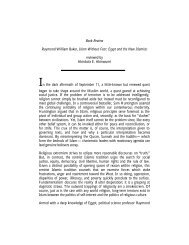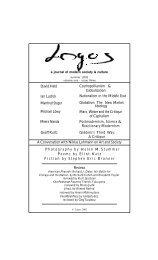Michael J. Thompson Stephen Eric Bronner Wadood Hamad - Logos
Michael J. Thompson Stephen Eric Bronner Wadood Hamad - Logos
Michael J. Thompson Stephen Eric Bronner Wadood Hamad - Logos
You also want an ePaper? Increase the reach of your titles
YUMPU automatically turns print PDFs into web optimized ePapers that Google loves.
Stanley Aronowitz<br />
coordination and of control expands with the complexity of the occupational<br />
structure and the manifold problems associated with advanced capitalism.<br />
Mills accepts the idea, first advanced by Berle and Means in the classic Modern<br />
Corporation and Private Property, that advanced capitalist societies are marked<br />
by the separation of ownership and control in the everyday functions of the<br />
large corporate enterprise, the owner has gradually handed more power to the<br />
manager. In turn, government and private corporations are run as rationalized<br />
bureaucracies rather than in the image of the individual corporate tycoon of the<br />
late 19th century who ran his business like an old fashioned sovereign.<br />
Although little more than elevated wage workers and, for this reason, deprived<br />
by their subordination to management, of the work autonomy enjoyed by the<br />
“old” middle class, the salaried professional and technical strata remain<br />
culturally tied to capital. Mills saw little hope for their unionization as long as<br />
mass culture—their indigenous culture—was the “the main drift” of mass<br />
society. On the one hand, reared in images of American exceptionalism, they<br />
were the embodiments of the cultural aspiration for individual social mobility;<br />
on the other, their growth was accompanied by the proletarianization of<br />
professional and technical strata, proletarian because they neither owned their<br />
own productive property nor controlled their labor. Some may earn higher<br />
salaries than industrial workers but, in contrast to unionized workers who have<br />
the protection of a collective bargaining agreement limiting management’s<br />
rights, they were subordinated to arbitrary managerial authority in the<br />
performance of their tasks. Yet, their eyes were fixed on the stars. Lacking a<br />
secure class identity which is intrinsic to those engaged in the production and<br />
appropriation of things, as producers of “symbols” they were likely to remain<br />
an atomized mass, an oxymoron which signified what Erik Olin Wright later<br />
described as the “contradictory class location” into which they were thrust. As<br />
for the clerical and administrative employees they were cogs in the vast<br />
machinery of the “enormous file”; they were keepers of information and of the<br />
proliferating records accumulated by the growing significance of sales. (Mills<br />
1951 189-214)<br />
In the absence of social movements capable of making a genuine difference in<br />
power relations, these studies are directed to the general, largely “liberal center”<br />
for whom Mills never ceased to have mixed feelings. The liberals were a<br />
necessary ingredient of any possible grand coalition for social change, but this<br />
<strong>Logos</strong> 2.3 – Summer 2003




